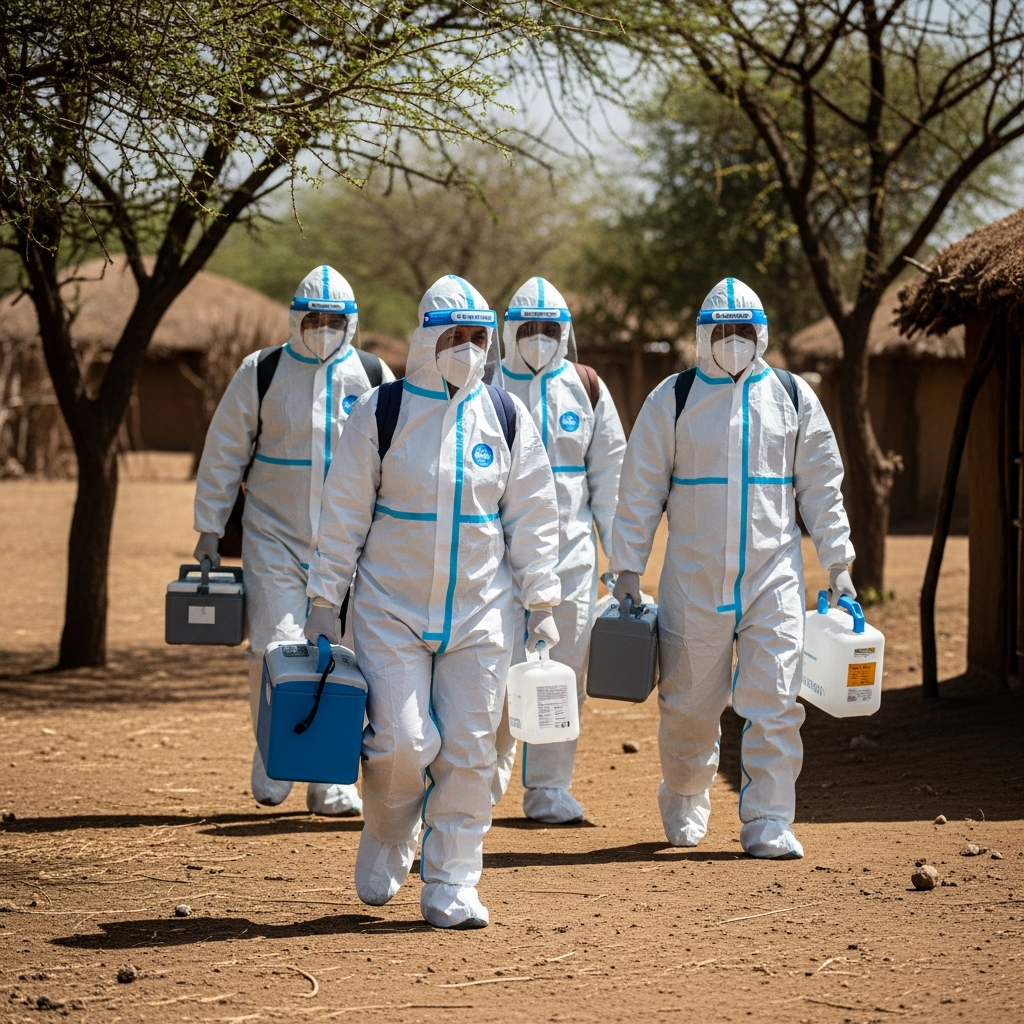The global health landscape is in constant flux, but some threats demand immediate attention. An alarming situation is unfolding in southern Ethiopia, where eight suspected cases of an unidentified viral hemorrhagic fever (VHF) have prompted a rapid, multi-faceted response from the World Health Organization (WHO). This urgent deployment underscores the persistent challenge of emerging infectious diseases, even as other public health crises, from measles resurgences to antibiotic resistance, continue to impact communities worldwide. This report delves into Ethiopia’s critical situation and highlights other key health updates from around the globe.
Ethiopia Faces Urgent Threat: WHO Mobilizes for Unidentified Viral Fever
In a significant move to avert a potential crisis, the World Health Organization has dispatched a specialized team and crucial medical supplies to Ethiopia. This swift action follows reports of eight suspected cases of viral hemorrhagic fever in the country’s South Ethiopia Region, alarmingly close to the border with South Sudan. The cause of this severe infection remains a mystery, intensifying the urgency of the international response.
Ethiopian health authorities are working tirelessly, ramping up their efforts with extensive laboratory testing at the Ethiopia Public Health Institute. Their goal is clear: identify the pathogen, understand its transmission dynamics, and stop its spread. The WHO’s support is comprehensive, including a multidisciplinary team of 11 technical officers. These experts bring invaluable experience in managing VHF outbreaks, focusing on critical areas such as:
Strengthening Disease Surveillance: Enhancing systems to detect new cases quickly.
Intensifying Case Investigation: Tracing contacts and understanding transmission routes.
Boosting Laboratory Capabilities: Accelerating pathogen identification.
Implementing Infection Prevention and Control (IPC): Protecting healthcare workers and limiting spread.
Improving Clinical Care: Ensuring effective patient management.
Coordinating Outbreak Response: Streamlining efforts across agencies.
Engaging Communities: Educating the public and fostering trust.
Financial and material support is also critical. The WHO has released US$300,000 from its Contingency Fund for Emergencies. Essential supplies include personal protective equipment (PPE) for frontline healthcare workers, vital infection-prevention materials, and a rapidly deployable isolation tent. These provisions aim to significantly improve clinical care and bolster management capacity in the affected region. The proximity to South Sudan, a nation with a fragile health system, adds another layer of concern, emphasizing the potential for cross-border transmission and regional instability.
Understanding Viral Hemorrhagic Fevers
Viral hemorrhagic fevers are a group of severe, epidemic-prone diseases. They are caused by several distinct families of viruses. Well-known examples include Marburg, Ebola, Crimean-Congo hemorrhagic fever, and Lassa fever. While symptoms can vary, initial signs often include high fever, profound fatigue, dizziness, muscle aches, weakness, and exhaustion. The WHO emphasizes that all suspected cases, whether isolated or in clusters, must be immediately reported to health authorities. This prompt notification is crucial, even before the causative pathogen is definitively identified, to enable rapid public health interventions. Ethiopia’s Health Ministry is expected to release further investigation results soon.
Measles on the Rise: A Concerning Resurgence in the US and Beyond
The United States is grappling with a significant measles resurgence, marking the highest activity since the disease was declared eliminated in 2000. The Centers for Disease Control and Prevention (CDC) recently reported 1,723 confirmed measles cases this year, spread across 43 jurisdictions. A startling 42 new cases emerged in just the past week. This figure dramatically surpasses last year’s total of 285 cases.
The data reveals a troubling pattern: 87% of current measles cases are associated with outbreaks. Forty-five distinct US outbreaks have been reported in 2025 alone. A critical factor in this spread is vaccination status. A striking 92% of measles patients were either unvaccinated or had an unknown vaccination history. In stark contrast, only 4% had received both recommended doses of the measles-containing vaccine. This highlights the vital role of comprehensive vaccination in preventing outbreaks.
The situation extends beyond US borders. Canada recently lost its measles elimination status, failing to contain a nationwide outbreak exceeding 5,000 infections for 12 months. This regrettable milestone also led to the loss of elimination status for the entire Americas region. While earlier reports suggested the US might follow suit in January 2026 due to a prolonged West Texas outbreak, an editor’s note clarified that this would only occur if a single outbreak persisted for a full year. Current US measles hotspots include the Utah-Arizona border and Upstate South Carolina, demonstrating the need for targeted public health interventions and robust vaccination campaigns in these areas.
Rethinking Antibiotics: “Watchful Waiting” for Pediatric Ear Infections Gains Ground
In a promising development for antibiotic stewardship, a new study advocates for wider adoption of “watchful waiting” for acute otitis media (AOM), commonly known as ear infections, in children. Published in the Journal of the Pediatric Infectious Diseases Society, this research suggests that a less immediate approach to antibiotics could significantly reduce unnecessary prescriptions.
Led by researchers from the University of Utah and Intermountain Health, the multicenter study analyzed over 140,000 AOM visits. Data came from children aged six months to 17 years across health systems in Illinois, Colorado, and Utah, spanning from July 2018 through December 2023. The study aimed to compare outcomes between immediate antibiotic prescriptions (within two days) and watchful waiting. Watchful waiting is a strategy where symptoms are monitored, and antibiotics are prescribed only if necessary, often as a delayed prescription.
The challenge is significant: approximately 100 million antibiotic courses are prescribed annually for AOM in children. However, more than 80% of these cases resolve spontaneously without medication. Despite strong evidence from randomized clinical trials showing that watchful waiting can reduce antibiotic use by about 60% with similar patient outcomes and satisfaction, it is currently utilized in only 5-20% of cases.
The study’s findings are compelling. Immediate antibiotics were prescribed in 84.4% of visits, while watchful waiting was used in 15.6%. Crucially, in the watchful waiting group, 56% of patients ultimately avoided antibiotics entirely. Only 44% received a delayed prescription. Both approaches showed low rates of treatment failure and recurrence. Just 6% of the watchful waiting group and 7% of the immediate antibiotic group required a new antibiotic within 3 to 30 days. These results highlight that watchful waiting offers favorable clinical outcomes, presenting a high-yield approach to minimize unnecessary antibiotic exposure for children. Encouraging broader adoption could be a critical step in combating antimicrobial resistance.
Alarming Antibiotic Resistance Found in Raw Milk from Pakistan
A recent study from Pakistan has raised serious public health concerns, revealing high levels of antibiotic-resistant bacteria in raw cow and sheep milk. Researchers from Abdul Wali Khan University Mardan published their findings in PLOS One. The study focused on Staphylococcus epidermidis (S. epidermidis), a common bacterium associated with subclinical mastitis in dairy animals, which can negatively impact milk quality and yield.
The context of milk consumption in Pakistan makes these findings particularly critical: over 95% of milk is consumed in its raw form. While S. epidermidis typically resides harmlessly on human skin, the presence of drug-resistant strains in milk poses a significant risk. These resistant bacteria have the potential to transfer their resistance genes to more harmful pathogens, such as methicillin-resistant Staphylococcus aureus (MRSA), through the food chain.
The study identified an overall prevalence of subclinical mastitis at 26%. Among 310 milk samples, 12.9% (40 samples) tested positive for S. epidermidis. Antibiotic susceptibility tests showed alarmingly high resistance rates among these isolates: 95% to both penicillin and erythromycin. Moderate resistance was observed for cotrimoxazole, doxycycline, clindamycin, and chloramphenicol, with lower rates for levofloxacin and ciprofloxacin. Disturbingly, half of the S. epidermidis isolates were classified as multidrug-resistant (MDR). Key resistance genes found included ermC (87.5%), tetK (80%), and mecA (45%).
The researchers attribute these high levels of resistance to the widespread use of antibiotics in dairy cattle and sheep for treating mastitis and other diseases. They emphasize that the presence of MDR Staphylococcus epidermidis in raw milk directly links on-farm antibiotic use to public health risks. The study underscores the urgent need for responsible antibiotic stewardship and improved hygiene practices within the dairy sector. Such measures are essential to reduce the transmission of antimicrobial resistance through the food chain and protect human health.
Global Public Health: Ongoing Challenges and Responses
Beyond these major incidents, the world continues to face a myriad of infectious disease challenges. These require constant vigilance and innovative public health responses.
Minnesota health officials, for example, are tracking a concerning rise in tularemia cases among humans and pets, particularly cats. This zoonotic disease, caused by Francisella tularensis*, highlights the ongoing risk of pathogens jumping from wildlife to domestic animals and humans. Early detection through methods like wastewater surveillance, as demonstrated by University of Minnesota research predicting COVID-19 trends a week in advance, proves invaluable for proactive public health management. Efforts to combat multidrug-resistant organisms (MDROs) are also advancing, with small trials exploring microbiota therapy (FMT) for high-risk patients in settings like long-term acute care hospitals.
The broader issue of inappropriate prescribing, extending beyond antibiotics to opioids and glucocorticoids in urgent care settings, remains a significant concern. A University of Michigan study revealed frequent unnecessary prescriptions, highlighting clinician knowledge gaps, patient demand, and insufficient decision support tools as contributing factors. This reinforces the critical need for robust stewardship programs and ongoing education for healthcare providers. Meanwhile, global alerts persist for diseases like chikungunya, mpox, and H5N1 avian flu, underscoring the interconnectedness of human, animal, and environmental health.
Frequently Asked Questions
What is a Viral Hemorrhagic Fever and why is the outbreak in Ethiopia concerning?
Viral Hemorrhagic Fevers (VHFs) are severe, often life-threatening diseases caused by various viruses, including Ebola and Marburg. They can lead to fever, fatigue, muscle aches, and bleeding. The current outbreak in Ethiopia is particularly concerning because the specific virus has not yet been identified. This lack of identification complicates targeted treatment and prevention strategies. Furthermore, the outbreak’s proximity to South Sudan, a region with a fragile health system, raises fears of potential cross-border spread, making rapid response and containment efforts critical.
Where can I find reliable information about measles vaccination and current US outbreak hotspots?
For the most reliable information on measles vaccination and current outbreak hotspots, the Centers for Disease Control and Prevention (CDC) website is the primary source. The CDC provides detailed statistics, vaccination guidelines, and updates on disease activity across the US. According to recent reports, current hotspots include the Utah-Arizona border and Upstate South Carolina. Health authorities emphasize the importance of vaccination to protect individuals and prevent further community transmission.
How can “watchful waiting” help reduce antibiotic use for children’s ear infections?
“Watchful waiting” for acute otitis media (AAOM), or ear infections in children, involves monitoring symptoms and only prescribing antibiotics if they worsen or persist. This strategy helps reduce unnecessary antibiotic use because over 80% of pediatric ear infections resolve spontaneously. Studies show it can reduce antibiotic prescriptions by about 60% with similar patient outcomes and satisfaction compared to immediate antibiotic use. By avoiding unnecessary antibiotics, this approach helps combat the broader issue of antimicrobial resistance while still ensuring effective care for children.
Conclusion: Vigilance and Global Cooperation Critical for Public Health
The ongoing public health challenges, from the urgent situation in Ethiopia to the global resurgence of measles and the persistent threat of antimicrobial resistance, highlight a crucial truth: health is a global endeavor. Rapid response, robust surveillance, and international collaboration are not just ideals; they are necessities. The efforts by organizations like the WHO, alongside national health authorities and researchers, are vital in navigating these complex landscapes. As we move forward, sustained vigilance, public education, and a commitment to evidence-based interventions will be paramount in protecting communities and building a healthier, more resilient world.




